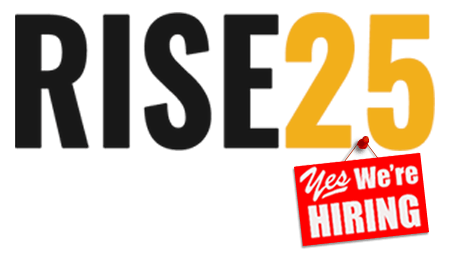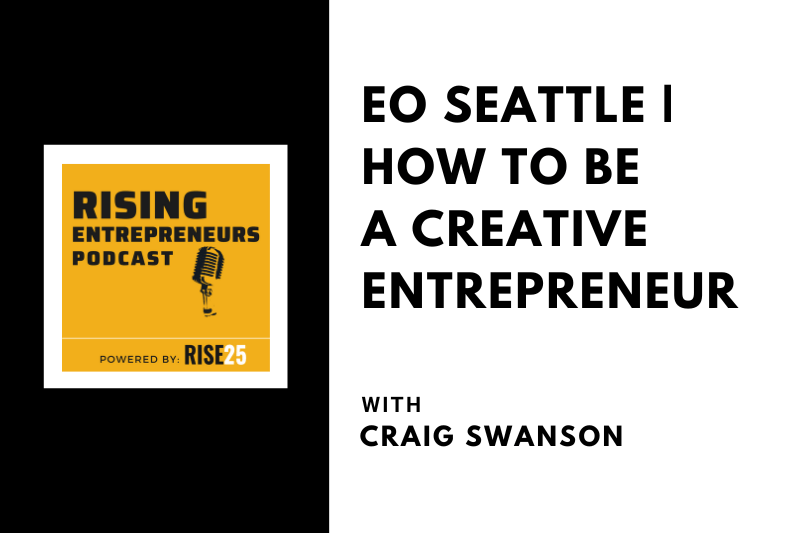 Craig Swanson is the Co-founder of CreativeLive, the world-leading live and online classroom for creative entrepreneurs. Getting his start delivering newspapers, Craig is a natural-born entrepreneur that loves the challenge of growing an online business from low six-figures to breaking $1M and building the team and systems to a scale far beyond. Craig is also a board member and the Accelerator Chair at EO Seattle, a partner in KaisaFit, and a consultant for Emerald.
Craig Swanson is the Co-founder of CreativeLive, the world-leading live and online classroom for creative entrepreneurs. Getting his start delivering newspapers, Craig is a natural-born entrepreneur that loves the challenge of growing an online business from low six-figures to breaking $1M and building the team and systems to a scale far beyond. Craig is also a board member and the Accelerator Chair at EO Seattle, a partner in KaisaFit, and a consultant for Emerald.
Here’s a glimpse of what you’ll learn:
- Craig Swanson’s entrepreneurial journey that started with a paper route (combined with delivering ice cream)
- How Craig combines his talents and love for creativity, publishing, and technology
- Balancing running a business, letting team members grow, and being a leader
- Why Craig rebranded Swanson Tech Support to CreativeTechs
- What prompted the beginnings of CreativeLive and how it’s evolved
- How Craig exited CreativeTechs
- Craig explains the growth and scaling of CreativeLive
- Partnering with and growing Sue Bryce and KaisaFit
In this episode…
As an entrepreneur, are you exercising your creative side? Where can you get the help you require to leverage your creativity and scale your business?
Creativity positively impacts the world, moving it forward and helping people foster ideas and become innovative. When you take knowledge and combine it with passion and your creative side, there’s no telling where you’ll go. Entrepreneur Craig Swanson combined his love for creativity, publishing, and technology, taking him on an entrepreneurial path he would not have foreseen. Leaders and entrepreneurs don’t always know how to use their creativity to achieve success. Creators and entrepreneurs can now learn ways to be creative in all aspects of design, photography, video, music, and entrepreneurship, thanks to CreativeLive.
In this episode of the Rising Entrepreneurs Podcast, John Corcoran sits down with Craig Swanson, Co-founder of CreativeLive. Craig talks about his entrepreneurial journey and what he learned along the way. He explains the early challenges he faced running his business, how he started and scaled CreativeLive, and his partnership with Sue Bryce and KaisaFit.
Resources mentioned in this episode
- EO Seattle
- EO Accelerator
- Entrepreneurs’ Organization (EO)
- John Corcoran on LinkedIn
- Rise25
- Craig Swanson
- Craig Swanson on LinkedIn
- CreativeLive
- CreativeTechs
- Chase Jarvis on LinkedIn
- Sue Bryce Education
- Emerald X
- KaisaFit
- EO Accelerator | Seattle
Sponsor for this episode…
At Rise25, we’re committed to helping you connect with your Dream 100 referral partners, clients, and strategic partners through our done-for-you podcast solution.
We’re a professional podcast production agency that makes creating a podcast effortless. Since 2009, our proven system has helped thousands of B2B businesses build strong relationships with referral partners, clients, and audiences without doing the hard work.
What do you need to start a podcast?
When you use our proven system, all you need is an idea and a voice. We handle the strategy, production, and distribution – you just need to show up and talk.
The Rise25 podcasting solution is designed to help you build a profitable podcast. This requires a specific strategy, and we’ve got that down pat. We focus on making sure you have a direct path to ROI, which is the most important component. Plus, our podcast production company takes any heavy lifting of production and distribution off your plate.
We make distribution easy.
We’ll distribute each episode across more than 11 unique channels, including iTunes, Spotify, and Google Podcasts. We’ll also create copy for each episode and promote your show across social media.
Co-founders Dr. Jeremy Weisz and John Corcoran credit podcasting as being the best thing they have ever done for their businesses. Podcasting connected them with the founders/CEOs of P90x, Atari, Einstein Bagels, Mattel, Rx Bars, YPO, EO, Lending Tree, FreshBooks, and many more.
The relationships you form through podcasting run deep. Jeremy and John became business partners through podcasting. They have even gone on family vacations and attended weddings of guests who have been on the podcast.
Podcast production has a lot of moving parts and is a big commitment on our end; we only want to work with people who are committed to their business and to cultivating amazing relationships.
Are you considering launching a podcast to acquire partnerships, clients, and referrals? Would you like to work with a podcast agency that wants you to win?
Contact us now at support@rise25.comor book a call at rise25.com/bookcall.
Rise25 Co-founders, Dr. Jeremy Weisz and John Corcoran, have been podcasting and advising about podcasting since 2008.
Episode Transcript
Intro 0:02
Welcome to the Rising Entrepreneurs Podcast where we feature top founders and entrepreneurs and their journey. Now let’s get started with the show.
John Corcoran 0:11
All right, welcome everyone. John Corcoran here. I’m the host of the show. And for those of you who are new to this program, check out our archives got lots of great interviews with past smart CEOs, founders, entrepreneurs of all kinds of companies. We got Netflix, Kinkos, YPO, EO activation, Blizzard, Lending Tree and many more. I’m also the co-founder Rise25 we help connect b2b business owners to their ideal prospects. I’m so excited to have this guest on here. Most of my guests come from a product, my own outreach, I’ve got a never ending stream of people that I’m interested in interviewing. This one actually was from an incoming solicitation, which is rare. But as soon as I saw it, I said, I really want to interview this guy. So this is Craig Swanson. He’s the one of the co-founders of CreativeLive, which is one of the first streaming educational platforms out there. We’ll talk about it in a moment. I actually was a guest on Dorie Clark’s CreativeLive a number of years ago and it was such a thrill to do but he’s got so many other things that he’s done. Longtime entrepreneur, partner and KaisaFit which is an online fitness platform. Also partner in the wedding school and online education for wedding photographers and portrait photographer business as well. Go check out for other podcasts interviews with him Built to Sell Podcast and every week. Craig talks about exiting those businesses. But he loves entrepreneurial challenges of growing businesses from low six figures to a million dollars or more. And he also is the chair of the accelerator program and EO Seattle. I’m a graduate of that program. It’s an amazing program for any entrepreneur out there who wants to go be able to break seven figures. So go check it out. And of course, before we get into this interview, this episode is brought to you by Rise25, where we help b2b businesses get clients referrals and strategic partnerships with done-for-you podcast and content marketing. And you can learn all about what we do at rise25.com. All right, Craig, it’s such a pleasure to have you here. And I want to start your longtime entrepreneur, so many people interview, some like come from like, some completely technical they’re an accidental entrepreneur didn’t intend to become an entrepreneur. But you seem like you had it in you from a young age, to the point where like many entrepreneurs, you have a paper route. But that wasn’t enough. You also had a creative way of generating nor more money during that paper route. What did you do?
Craig Swanson 2:26
Yeah, so I saw my first paper out of 10, because I was in a small town that allowed you to that that I moved to Seattle, you had to be 12. And so I had to wait like a year before I got my paper out, got my paper out at 12 got the largest number I could get, I think I’d like 350 papers on this thing. And then I realized I was like cycling through the summer and like riding my bike or so I went down to downtown, I got a wholesaler license, I got a business license and I basically built an ice cream truck that I carried on the back of my bicycle when I was delivering newspapers. And so I was delivering newspapers riding through all the neighborhoods and selling ice cream at the same time.
John Corcoran 3:05
It’s not enough that you’re lugging all these newspapers, you also have to lug a refrigerator.
Craig Swanson 3:11
We couldn’t do it on Wednesdays because Wednesday’s are thick papers. And we certainly didn’t try to do it on Sundays. But yes, basically, Monday, Tuesday, Thursday and Friday are nice light papers. I could totally throw in some ice cream cart in the back.
John Corcoran 3:24
Do you remember being 12 years old and either telling your parents or showing up downtown, this 12 year old saying I want to get a commercial license. I mean, do you remember that experience?
Craig Swanson 3:36
I really wish. So I suspect I just showed up. I just told my parents one day that I had got the commercial license and needed a a ride to the wholesale building because I need to pick the stuff up. That would be my style. In fact, so I have a son, I have a son who just turned 20. And I remember when he turned 13. I called up my parents I said so, what did you do when I was 13 to like, encourage me to go do this stuff. And they just looked at me and shook their head that we had nothing to do with that. Like you would come home with these ideas and start building stuff. And this was definitely a if there was nurture in it. There was a lot of nature built into that there’s a lot that you just kind of like took and ran with.
John Corcoran 4:21
Well, it does get into a whole another conversation about nature versus nurture in entrepreneurship. But the next thing I want to ask you about is when you got the high school, you were involved in your high school newspaper, I was involved my high school newspaper, mid 90s. At that time, there’s some really early primitive software that we’re using, but you were digitizing your high school newspaper from an early age this is probably moving from laying things out physically I imagined to doing it more on a computer what was that like?
Craig Swanson 4:54
So yeah, so let’s see here. The Apple Macintosh had come out. So I graduated 1988. So between 1984 and 1988 is kind of when the first Macintosh came out. And I think the first Adobe laser printer came out around that time. So my first year in the newspaper, we would send out our type to a line of Tronic typesetting house that was part of the district. And they would basically type these things up and send them out to us. And I wanted to do some special things. So I literally would like ride my bike out because another car at that time, and I would be telling the ladies what I wanted, because I wanted a special headlines. These are things and I don’t know why that is like people just let me they just, they leave and they let me talk my way into things. But they literally like let me get in front of the machine and start typing in that old code, how to like do my own typesetting. And they’re like, let me do custom stuff. Maybe I even I’m just astounded by it. So a year later, that same journalism department bought the first laser printer back when laser printers were brand new.
John Corcoran 6:05
And not cheap, probably at that point too.
Craig Swanson 6:06
No. And this would have been and we were using PageMaker 1.0 is probably an $8,000 laser printer and it will take forever to print. And we switched over from sending out from galleys of type to basically printing out on thick paper stock, printing it out, pasting up the like I did the editorial board and a couple others. And I just loved it. I poured myself into this thing. And we pasted up we did the paste up at a local printing press where the local weekly newspaper was printed for Redmond Issaquah and Bellevue. There was a weekly, I ended up like pasting up my high school newspaper next to the guys that were doing the weekly production on the Bellevue popery, and the Kirkland curry review and the Redmond whatever we call it. And then my senior year, they hired me 30 hours a week to basically run the production department like to start doing the production department on computers because they were switching over and no one knew how to do it. So I had a full time job.
John Corcoran 7:06
Over here. He’s doing it for the local high school newspaper obviously knows how to do it.
Craig Swanson 7:09
Exactly. So I was doing my local high school newspaper, and then three local newspapers in the Seattle area. I say I dropped out of high school at that point, I just basically stopped going to high school at that point, because I had a 30 hour a week job. And I had an acceptance letter to the University of Washington that didn’t include the paragraph that said, based on future grades, which most of my friends had. So I said, okay, well, it’s not based on future grades. So what do I care about future grades. So I just stopped going to school, except for I think, journalism, calculus, and worked at the newspaper, I did all this production. And that basically led into my first job right out of college, which was my graphic designers.
John Corcoran 7:56
I love doing that work out. And so I was editor of my high school newspaper, and I loved laying it out. I love taking these different stories love the creativity, within the constraints of a newspaper. I remember driving, I lived in LA. So driving from San Fernando Valley all the way to Glendale, which is where our printer was having to go there to check on things. And back, then things would get messed up. And we’d get like 1000 papers printed up that had some major thing wrong with them, because we didn’t have a good way of getting proofs or anything like that. All kinds of mistakes and stuff that would happen.
Craig Swanson 8:25
So what am I, what am I I’m 52 now, and I’ve been in business, basically, since I was 18, 19. There is so much about my understanding about you launch businesses run life and basically just kind of work as a creator and an entrepreneur from journalistic production, this idea of we went to press every week, every week on Thursday, we were done. We were done with the best work we could do up until the point that the deadline occurred, and then you ship. So we shipped with the best thing we could every Thursday night. If I want to stay up till 1am I could do that. But basically, there’s a point at which you ship it doesn’t matter if you’ve not filled in something. There’s a white sheet, there’s a white piece of paper that doesn’t have your work on it that goes out printed the next morning.
John Corcoran 9:14
And you can see that rhythm showing up in CreativeLive later, which I want to get to. But before we do, yeah, makes total sense that you eventually get into doing IT support for graphic designers, because it seems like it was kind of next evolution, that was Swanson tech support. So talk about how you evolves from supporting those newspapers into this business.
Craig Swanson 9:35
So I mean, effectively I went to college as a graphic design major realized that really, I was a technology major and I loved working with creatives. So I started an IT company in 1988, which was teaching computers to graphic designers at agencies, design firms and photography studios in the greater Seattle area. And the fact that I was 18 years old didn’t mean anything in terms of my qualifications other than, like, maybe my professionalism and just understanding of life, because nobody actually knew the technology at that point. And, really from that year up until when I sold that business in 2010 through various variations, I just was working to create support systems, generally around technology for commercial creatives, for, for photographers, for writers, for ad agencies, for design firms. And I am very, very technical, I’ve been able to sell my intelligence in trade for time and, and trade for money. But it’s always been within this support structure of helping creatives publish, create, find stability, and basically run their businesses around technology. So it’s this way, I’ve combined these two sides of me into something that I just absolutely love.
John Corcoran 11:03
Yeah. Now, for you, one of the challenges early on was hiring, you said that that was a big struggle for you was getting good people in place and kind of replacing yourself and not being the one who was inter woven in the threads of the business. So to talk a little bit about those early challenges.
[Continue to Page 2]








